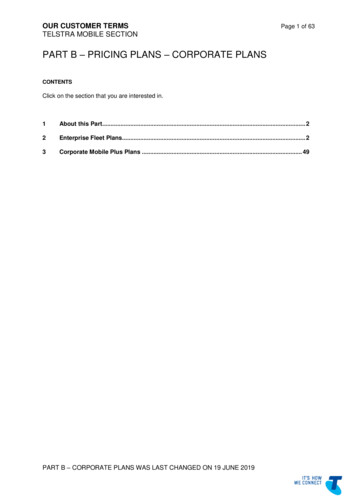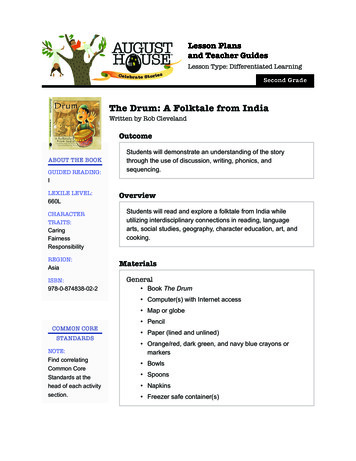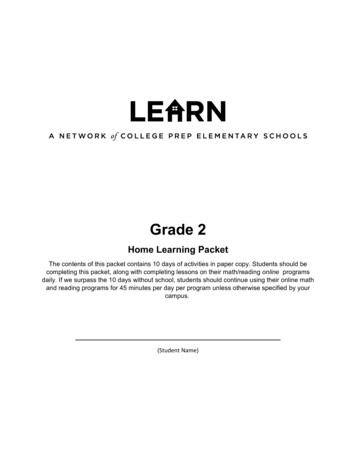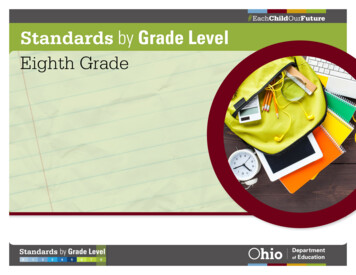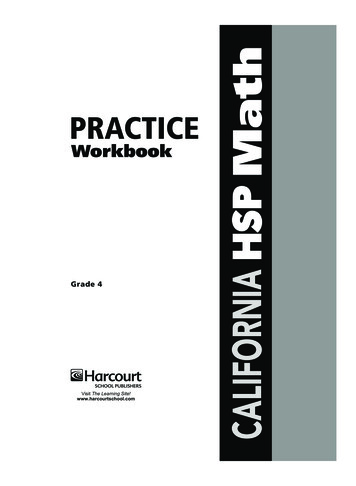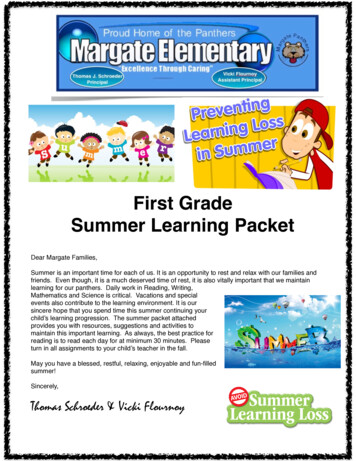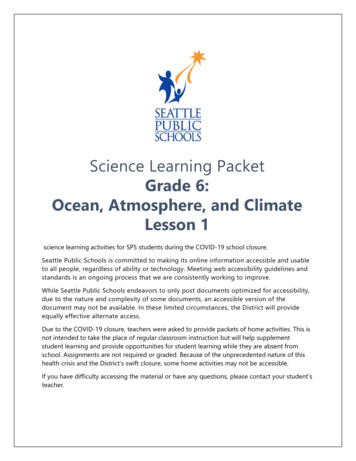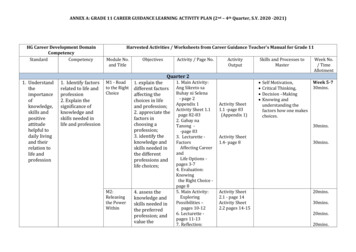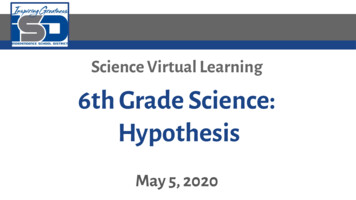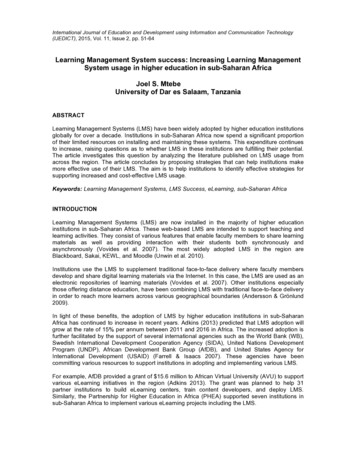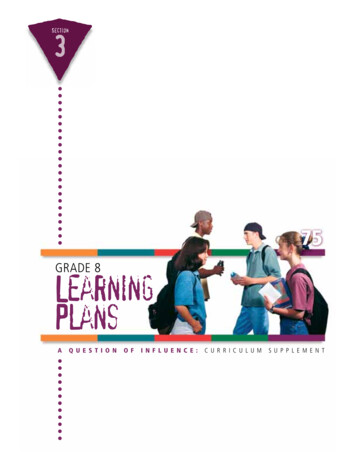
Transcription
Section375GRADE 8LearningPlansAQ U E S T I O NO FI N F L U E N C E :C U R R I C U L U MS U P P L E M E N T
A QUESTION OF INFLUENCEGRADE 8 LEARNING PLANS77SECTION3INTRODUCTION TO THE GRADE 8 UNITThe overall aims of this grade 8 unit are to strengthen students’understanding of the factors that influence substance-use decisions and tohelp them make healthy substance-use decisions. An important ingredient ofsound decision making is having a clear understanding of risks and harmslinked to substance use—those concerning alcohol and cannabis mainly willbe presented. The remainder of the unit aims to increase knowledge andskills pertaining to family and media influences.The assumption here is that alcohol and/or cannabis will still be thesubstances of choice and most easily available. However, the Nova ScotiaStudent Drug Use Survey 2007 shows that hallucinogens (mescaline orpsilocybin) are the third most frequently used category of psychoactivesubstances. The Healthy Living curriculum also identifies a discussion ofover-the-counter and prescription drug misuse as required outcomes forgrade 8 students. The best knowledge available on junior high schoollevel drug education advises that the program focus on the drugs thatare available to students rather than provide a broad education on allsubstances. Yet, what is available and what is in use can change at a fasterpace than survey data can report. This first lesson in Healthy Living 8is designed to help teachers identify what other substances are availableto their students to help them tailor the activity plans to those specificsubstances.Grade 8 Unit Overview1Suggestions for assessingother aspects of studentperformance throughout theunit can be found in AppendixD.The grade 8 component of A Question of Influence covers the three spheresof influence—personal, social, and cultural—in the form of three learningthemes: how I influence myself, how others influence me, and how I aminfluenced by the world around me. Each learning theme includes a setof activities and associated teacher and student materials matched to theNova Scotia Healthy Living curriculum outcomes for grade 8. The threelearning themes are preceded by an introductory session that introducesthe complete unit to the students and lays the foundation for the learningtheme activities. A fifth and final wrap-up session completes the unit. It isdesigned to encourage students to reflect on what they have learned aboutwhat influences their decisions around alcohol, cannabis, and other drugs.It also provides the teacher with an opportunity to assess what studentshave learned from the unit as a whole.1[CONTENT OF THIS PAGE UPDATED APRIL 2008]
A QUESTION OF INFLUENCEGRADE 8 LEARNING PLANS78SECTION3Each of the three learning themes, the introductory session, and wrapup session begin with introductory notes to help orient the teacher to thecontent of that session or learning theme. A summary table is provided atthe beginning of each session/learning theme to identify the Healthy Livingcurriculum outcome links, specific activity objectives, estimated time frame,and preparation required to work through each activity in class. Separatepages for teaching aids, referred to as “slides” throughout the unit, andstudent handout materials are found at the back of the unit.The time estimates included here are based on the actual outcomes of theresource field test in the winter and spring of 2006. The complete unit isintended to be delivered in no more than six hours of instructional time ora maximum of eight 45-minute classes. Not every teacher will have HealthyLiving classes that run for 45 minutes, and the delivery of the activities willhave to be adapted based on the length of class time available.It is strongly recommended that none of the learning themes be dropped inorder to shorten the time required to deliver the unit. Instead, suggestionsfor shortening individual activities include the following: Reduce the number of case studies or stories used for group activities. Reduce the number of groups and increase the group sizes. If increasingthe size of small groups is not an option, assign the same story to morethan one group, ask one group to report back on the story and, once theyfinish their report, ask the other groups with the same story if they haveanything to add. Place strict time limits on brainstorming activities (five minutes, forexample) rather than trying to get every last idea or comment. Place case studies on slides and discuss them with the entire class.A NOTE ON THE APPROACH TAKEN WITH THIS SUPPLEMENTThis supplement is based largely on the Social Influences Model—thedrug education approach that has been shown by research over the past25 years to be most effective for junior high school students. This modelsees adolescent use of substances as the result of influences from peers, themedia, and the general culture. These social influences take the form ofmessages that appear to condone substance use: for example, modellingof alcohol and other drug use by peers and media personalities, persuasiveadvertising appeals, and/or direct offers by peers to use substances. For thepurposes of this supplement, personal influences stemming from normaladolescent development (e.g., need for independence, to experience risk)
A QUESTION OF INFLUENCEGRADE 8 LEARNING PLANS79SECTION3are also viewed as an important source of influence. This model aims tocreate greater awareness of these three spheres of influence—personal, socialor interpersonal, and cultural or environmental—and to develop skills toanalyse and minimize their impact.A NOTE ON THE USE OF THE TERM “CANNABIS”The term “cannabis” is used throughout the resource. During the field-testphase of resource development, some students commented that “cannabis”was a new word for them. Although junior high students are more familiarwith the term “marijuana,” the resource continues to use “cannabis” as itis a more inclusive term, including marijuana, hash, and hash oil. It will behelpful to the students if teachers explain to them that the term cannabis willbe used to refer to the substance they may know as marijuana, pot, weed,dope, grass, or hash/hash oil.
A QUESTION OF INFLUENCEGRADE 8 LEARNING PLANS80SECTION3FIRST CLASS—INTRODUCING GRADE 8 STUDENTS TO THE UNITIntroductionThis first session of Healthy Living 8 includes a very brief refresher on theconcept of influencing factors connected to alcohol, cannabis, and otherdrug-related decision making. It carries through with the Healthy Living 7curriculum outcome “Identify personal, social, and cultural influences relatedto alcohol, cannabis, and other drug use (B3.7)” that forms the foundationof this curriculum supplement. It also introduces grade 8 students to theentire unit and sets the stage for an ongoing discussion on alcohol, cannabis,and other drugs. The first class includes a brief brainstorming activity thatasks students to reflect on the substances that are actually available in theircommunity as well as the substances that they suspect are being experimentedwith by other students in their school or community. This provides studentswith the opportunity to consider the role that environmental influences (e.g.,what substances are available) and social influences (e.g., what their peers aredoing) may play in their own substance-use choices.Grade 8 Introductory SessionHealthy LivingCurriculum LinksIdentify personal, social,and cultural influencesrelated to alcohol,cannabis, other drug use,and gambling (B3.7 andreinforce Healthy Living 7B3.7)Activity Objective(s)ActivitiesTime FramePreparationMaterialsTo introduce studentsto the entire unit and setthe stage for an ongoingdiscussion on alcohol,cannabis, and other drugsIf introducing Circles of Influence forthe first time, it is recommended thatstudents complete Activity 7.1 fromHealthy Living 7Up to 30minutesPrepare Slide8.A—Circlesof Influence, ifneeded.OverheadprojectorFlip chart orblackboardActivity 7.1Circles of Influence- The teacherreviews the concept of multiple typesof influences on student decisionmaking and describes upcomingactivitiesActivity 8.1What Substances Are in OurCommunity?—Through abrainstorming exercise, studentsidentify the substances available tothem in their community and considerthe implications of the availability ofthese substances.Up to 45minutes ifintroducingthe Circles ofInfluence for thefirst time
Teacher guide linesA QUESTION OF INFLUENCEGRADE 8 LEARNING PLANS81Activity.18TEACHER’S NOTESACTIVITY 8.1:What Substances Are in Our Community? NoteThe instructions for this first class are written as if grade 8 students havebeen exposed to the concept of three types of influences that can affect theirdecisions around alcohol, cannabis, and other drugs. In the first year that AQuestion of Influence is used in the Nova Scotia school system (2006–2007),teachers will need to extend the length of time for this introductory class andadd Activity 7.1: Circles of Influence from the grade 7 unit (see pages 41-42).Insert instruction points 1 through 3 of that activity into the beginning of thisintroduction to the grade 8 unit and drop instruction point 1 below.1. Remind students that the material on alcohol, cannabis, and other drugsthey have covered in Healthy Living 7 classes has looked at three types ofinfluencing factors that can have an impact on their decisions and behaviour.Ask the students to recall the three types of influences. Explain that the activitiesthat will be covered in Healthy Living 8 also look at ways they can influencethemselves, how others influence them, and how they are influenced by theworld around them. Explain to the students that the activities related to thethree types of influence in this unit are more in-depth than in previous grades.2. Explain to the students that two things that can influence their decisionsabout alcohol, cannabis, or other drugs are what they see others doingand what substances are available. If the upcoming activities are to beuseful, they need to focus on the substances they are most likely to face.As a result, ask for their input on what they know for sure is availableright here in this community. Stress that you are not assuming that theyare using anything nor are you asking them what, if anything, they areusing. You are just looking for a list of substances that should be the focusof the upcoming classes, based on what the students know for sure.Ask the students to answer the following questions: What substances are available to you at home, at school, and in thecommunity? What do you know for certain that other teens in our community are using? Is there anything special or unique about how they are using the
Teacher guide linesA QUESTION OF INFLUENCEGRADE 8 LEARNING PLANS82Activity.18TEACHER’S NOTESsubstance (smoking it, washing down with alcohol, or combining withanother drug)?Depending on your sense of which approach would draw moreinformation, you can use an open or anonymous approach. In theopen approach, have students come up to the flip chart or board (asa group, not one by one) and write things down. In the anonymousapproach, students can write their responses on slips of paper. Askthem to put their responses in a box that you circulate among thestudents. Try to have every student contribute.3. Finally, take stock of all the responses and draw some conclusions. Lookat which substances come up most frequently (e.g., some form of alcoholand cannabis) and what follows after these (e.g., mushrooms, some kindof prescription drug). You may need to ask for clarification on some ofthe items, depending on street names, etc. Try to end up with a shortlist of four categories such as alcohol, cannabis, prescription meds, andmushrooms. Appendix B: Understanding Drug Influences, Risks, andEffects can help you with categorizing different drugs.4. Once you have a short list, ask the class “Does this look accurate? Ifwe concentrate on these substances, will it provide you with enoughinformation on the things you might run into to make sound decisions? Ifthe answer is yes, end the lesson by indicating that these substances willshow up in the future activities. If the answer is no, ask, “What is missingor should not be here?” and change the list until the class agrees.You may encounter one student who is adamant about one specific drug,even though it is not really something everyone agrees they will encounter.Keep the substance on the list and assign it to that student as a part of theprocess of developing survey questions in the next session. NoteThe case studies and activities throughout this unit emphasize alcohol andcannabis. Based on the results of students’ identification of what is availableto them, you may want to incorporate these substances into LearningThemes One and Two by adding an additional substance to the surveyquestions and switching the substances mentioned in the stories.
A QUESTION OF INFLUENCEGRADE 8 LEARNING PLANS83SECTION3LEARNING THEME ONE: HOW I INFLUENCE MYSELFIntroductionA major source of self-influence for adolescents is their access toaccurate knowledge and their ability to identify and correct commonmisconceptions. The purpose of this activity plan is to clarify commonstudent misperceptions concerning alcohol, cannabis, and pharmaceuticalproducts and to provide them with a greater understanding of the risks. Therisks addressed include injury, longer-term health problems, and cominginto conflict with the law. This will be accomplished through students’participation in a “game show” where teams compete with each otherto come up with the correct response to a series of questions on the risksassociated with the use of alcohol, cannabis, and other drugs.
A QUESTION OF INFLUENCEGRADE 8 LEARNING PLANS84SECTION3Grade 8 Learning Theme One—How I Influence MyselfHealthy LivingCurriculum LinksDemonstrate anunderstanding of the risksassociated with the useof alcohol, cannabis, andother drugs (B3.6)Activity Objective(s)To provide studentswith an understandingof the legal implicationsof possessing or usingalcohol, cannabis, or overthe-counter/prescriptiondrugs at their ageActivitiesActivity 8.2The Game Show—Knowingthe Risks of Alcohol andOther Drugs—By working asteams, students compete ina “Reach for the Top” typeDemonstrategame show to decide theknowledge of laws relatedcorrect answer to a seriesto alcohol, cannabis, other To provide students with of questions on alcohol anddrugs, and gambling (B3.5) an understanding of theother drug-related risks.risks involved with the useof alcohol and cannabis,and the non-medical useof over-the-counter andprescription medicationsTime FramePreparationUp to 90minutes;two 45-minuteclassesPreview the 15 items onStudent Handout 8.A and8.B. If students identified asubstance through Activity8.1 that is not coveredin the 15 items, refer toAppendix C: DetailedInformation for SelectedDrugs to develop one ortwo additional questions onthe risks of that substanceand write them in on thehandouts.Make copies of StudentHandouts 8.A—Risk-Wise,Part One and 8.B—RiskWise, Part Two.Get five to six bells, whistles,or other noisemakers, onefor each class team.Materials
Teacher guide linesA QUESTION OF INFLUENCEGRADE 8 LEARNING PLANS85Activity.28TEACHER’S NOTESACTIVITY 8.2:The Game Show—Knowing the Risks ofAlcohol and Other Drugs NoteThis activity includes 15 (potentially one or two more) alcohol and otherdrug risk–related items and their correct responses. Having teams respondto these items and discussing the correct result will be time consuming.The best way to maximize discussion of the risks is to divide the items inhalf and complete the game over two classes. The students will be giventhe questions at the start of each class to discuss in teams before the gamebegins. The statements have been divided into two handouts so that teamscannot research their responses between the first and second classes.1. Begin the session by explaining to the class that research has shown that,when making decisions about trying alcohol and other drugs, teenagersare often influenced by their perception and knowledge of what risksare connected to using a specific substance. The risks can include healtheffects and getting into trouble with the law. In addition, one substancemay carry greater or lesser risks than another substance. Tell the class thatthe next session or two will take a look at how “risk-wise” they are andwill give them the opportunity to compete in a game.2. Divide the class into teams of five to six students. Explain that each teamis going to be given a sheet of seven to eight statements and asked todecide whether they agree or disagree with each statement. They will haveabout 10 minutes to do this. They can then appoint a team “mouth” torepresent the team in a competition against other teams to come up withthe most correct responses to the statements. Once the groups are formed,give each team a copy of Student Handout 8.A—Risk-Wise, Part One.3. After the teams have worked for 10 minutes, line up the team “mouths”at the front of the class and give each “mouth” a noisemaker. Explainthat you are going to read each statement, and the “mouths” are to maketheir noise as fast as they can to see who gets to go first. Ask a student tovolunteer to be the scorekeeper and ask them to keep track of each team’sresponses.
Teacher guide linesA QUESTION OF INFLUENCEGRADE 8 LEARNING PLANS86Activity.28TEACHER’S NOTES4. Once the teams have responded to all the questions on Student Handout8.A—Risk-Wise, Part One, read out the correct response to each itemfrom the responses on pages 87-89 and discuss it with the students. Havethe scorekeeper give each team one point for their correct responses andno points for their incorrect responses.5. Repeat steps 2 through 4 in the second class, using the same teams and“mouths” and Student Handout 8.B—Risk-Wise, Part Two (responses onpages 89-91). Add up the scores to determine the winning team.6. Once all the questions from the two student handouts have beendiscussed, ask the class to describe and draw conclusions from what theyhave learned from the activity about the risks of alcohol, cannabis, andother drugs.
Teacher guide linesA QUESTION OF INFLUENCEGRADE 8 LEARNING PLANS87Activity.28TEACHER’S NOTESACTIVITY 8.2:Game Show Answer Key1. Alcohol is only a risk to you if you are older and have been using it formany years. [Disagree is correct].Alcohol can pose health risks no matter what your age, no matter ifyou have been drinking for years or if this is your first experience withalcohol. While alcohol is associated with longer term, chronic health riskssuch as liver disease, young people who drink to get drunk are placingthemselves at risk for accidents, violence, and alcohol poisoning.2. It is not dangerous to drink and drive if you stay on the back roads.[Disagree is correct].Driving a car requires attention, judgment, and sound decision making,no matter what road you are on. Consuming alcohol can have negativeeffects on the skills required to drive well. Drinking any amount anddriving can be extremely dangerous, particularly for young drivers.3. Smoking the occasional joint is not too harmful for a teenager.[Disagree is correct].That may be so, but the harms associated with smoking even theoccasional joint depend on what’s in the joint (for example, is it mixedwith another drug), the amount of THC present, and the circumstancessurrounding use, such as location and combining cannabis with alcoholor other drugs. Depending on these factors, even one joint may contributeto a harmful outcome. It’s also against the law, and police may apprehendeven an occasional user.4. The health risks from cannabis have never been proven.[Disagree is correct].This statement is an old myth. While it may have been true at one time,there is now a good body of research documenting the health risks ofcannabis use. These include lung dam
understanding of the factors that infl uence substance-use decisions and to help them make healthy substance-use decisions. An important ingredient of sound decision making is having a clear understanding of risks and harms linked to substance use—those

